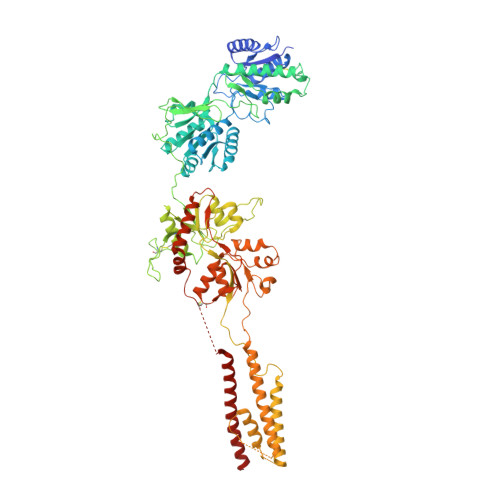Gating mechanism and a modulatory niche of human GluN1-GluN2A NMDA receptors.
Wang, H., Lv, S., Stroebel, D., Zhang, J., Pan, Y., Huang, X., Zhang, X., Paoletti, P., Zhu, S.(2021) Neuron 109: 2443-2456.e5
- PubMed: 34186027
- DOI: https://doi.org/10.1016/j.neuron.2021.05.031
- Primary Citation of Related Structures:
7EOQ, 7EOR, 7EOS, 7EOT, 7EOU - PubMed Abstract:
N-methyl-D-aspartate (NMDA) receptors are glutamate-gated calcium-permeable ion channels that are widely implicated in synaptic transmission and plasticity. Here, we report a gallery of cryo-electron microscopy (cryo-EM) structures of the human GluN1-GluN2A NMDA receptor at an overall resolution of 4 Å in complex with distinct ligands or modulators. In the full-length context of GluN1-GluN2A receptors, we visualize the competitive antagonists bound to the ligand-binding domains (LBDs) of GluN1 and GluN2A subunits, respectively. We reveal that the binding of positive allosteric modulator shortens the distance between LBDs and the transmembrane domain (TMD), which further stretches the opening of the gate. In addition, we unexpectedly visualize the binding cavity of the "foot-in-the-door" blocker 9-aminoacridine within the LBD-TMD linker region, differing from the conventional "trapping" blocker binding site at the vestibule within the TMD. Our study provides molecular insights into the crosstalk between LBDs and TMD during channel activation, inhibition, and allosteric transition.
Organizational Affiliation:
Institute of Neuroscience, State Key Laboratory of Neuroscience, CAS Center for Excellence in Brain Science and Intelligence Technology, Chinese Academy of Sciences, Shanghai 200031, China; University of Chinese Academy of Sciences, Beijing 100049, China.





















